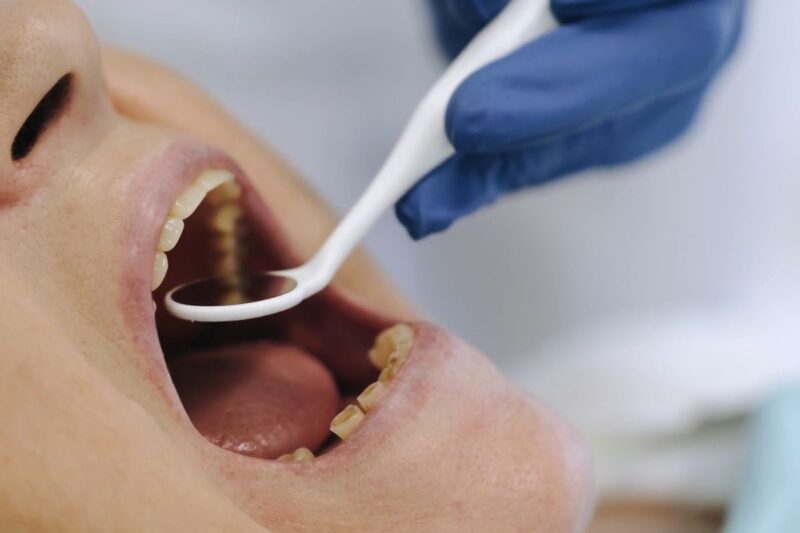You might feel uneasy if you spot a bone-like growth in your mouth. That bump can be a small sign of irritation, a harmless torus, or something that needs closer attention. Non-cancerous tumors of the mouth are generally not life-threatening, yet it is wise to stay alert.
Canker sores, oral warts, and fibromas can all present as an abnormal growth in mouth tissues, but they often resolve or cause minor complications.
Some people have a genetic predisposition toward bony protrusions called torus palatinus or torus mandibularis, which form as part of natural jawbone structure. These and other benign conditions can create a Bone-Like Growth on Gums without signaling a major health crisis.
You should still watch for serious indicators, like persistent pain or swelling, and seek professional help if foul odors or intense soreness appear.
A dental exam can clarify whether the cause is minor or if infection, abscess, or a growth such as oral cancer is involved. Untreated issues might worsen, so meeting with your dentist is a proactive step. Paying attention to what feels normal and acting when something changes is key to staying in control of your oral health.
Appearance of a Bone-Like Spot in Your Gums
You might feel a firm bump that seems to emerge from underlying bone. This can suggest a possible gum tissue abnormality that needs a closer look. A slow-growing protrusion often indicates something benign, yet vigilance helps prevent unwelcome surprises.
Early detection and regular visits to respected professionals like the American Dental Association–accredited dentists preserve long-term oral health.
A thorough gum growth examination alerts you to changes before they become severe. Oral fibromas, for example, are one of the most frequent causes of tumor-like lumps. They often originate from repeated irritation or friction and may stay symptom-free unless they grow large.
Dental cysts typically form around the roots of damaged teeth and usually remain painless unless infection sets in.
Identifying Minor Abnormal Growth in the Mouth
Small bumps can arise due to malocclusion, dental appliances, or genetic tendencies. Pyogenic granulomas appear as soft, reddish lumps that may bleed with slight pressure. Mandibular tori, on the other hand, are slow-growing bony deposits that rarely cause discomfort. A simple gum growth examination provides clarity on whether immediate treatment is necessary.
- Repeated friction from misaligned teeth can trigger minor lumps
- Oral fibromas often develop from consistent tissue trauma
- Pyogenic granulomas may stem from slight injury or hormonal shifts
How a Jaw Bone Growth or Gum Tissue Abnormality May Develop
Shifts in jaw alignment or ongoing gum tissue irritation foster these areas of extra growth. Some conditions progress stealthily over time. Early signs include a sense of pressure or a raised surface near the gum line. Prompt monitoring ensures an accurate diagnosis and helps determine if benign care or advanced intervention is needed.
| Type of Growth | Possible Cause | Typical Development |
|---|---|---|
| Oral Fibroma | Irritated gum tissue | Slow, often unnoticed |
| Pyogenic Granuloma | Slight injury or hormonal change | Reddish lump that bleeds easily |
| Dental Cyst | Buried or dead tooth root | Minimal symptoms unless infected |
| Mandibular Tori | Slow bone overgrowth | Gradual, often painless |
Common Causes of Bone-Like Growth on Gums
@happystranger9 #stitch with @drrashti lets talk tori and exostosis! #goviral #fyp #foryoupage ♬ Carrying Your Love – David Morris
Bony protrusions often develop due to inherited traits and unique mouth conditions. Some individuals are prone to jaw bone growth, which can appear near the gum line and affect bite comfort.
Missing or impacted teeth may contribute to tooth growth on gums, causing pressure that triggers new bone formation.
These lumps may feel hard, yet they do not always indicate a serious disorder. Genetic factors, along with malocclusion, sometimes produce extra bony tissue as a protective response to uneven pressure.
Not all lumps demand treatment, though dentists might recommend removal if the protrusion compromises daily oral care or rubs against dentures.
Genetic Inheritance and Jawbone Development
Family history can set the stage for bigger bone structures in the mouth. A father’s genetic makeup may pass down tendencies for stronger or thicker bone, leading to noticeable enlargements over time.
Dental Anomalies and Tooth Growth on Gums

An impacted tooth can push against surrounding tissue and create slight bony elevations. That shift in alignment can encourage tooth growth on gums, sometimes leading to tenderness or difficulty chewing.
Benign Growths Such as Exostosis or Torus
These formations are generally harmless, though friction may cause discomfort. Many individuals in the U.S. live with tori or exostosis without complications. Adjustment becomes necessary if they interfere with bite function or make devices like dentures painful.
| Cause | Description |
|---|---|
| Inherited Traits | Family-related factors may contribute to extra jaw bone growth. |
| Dental Irregularities | Impacted or misaligned teeth provoke tooth growth on gums. |
| Benign Bony Protrusions | Exostosis or torus remain noncancerous yet can cause mild irritation. |
Signs That May Indicate a Serious Oral Health Concern
You may notice a bump that never seems to fade or a sore that lingers for weeks. Such changes can point to a more serious problem and should be evaluated without delay. A foul odor or pain that refuses to improve could reveal issues like abscesses or advanced gum disease.
Nearly 30% of adults report chronic bad breath, which may connect to deeper gum problems.
Difficulty chewing or swallowing might also be a warning. That discomfort grows if a lump increases in size or shows discoloration. Some growths stem from a jawbone development issue that worsens over time. Specialists note that early detection often increases successful outcomes, especially when oral abnormalities last longer than two weeks.
“Proper screening and swift intervention can reduce the risk of complications linked to persistent gum lumps or sores.”
The average age for oral cancer diagnosis is 63, yet around one in five cases involve younger patients. Regular check-ups help catch suspicious developments early. If you sense ongoing swelling or pain, it is wise to consult your dental provider and take the next steps toward protecting your oral health.
When to Seek Professional Evaluation
Paying attention to lumps and unusual tissue changes on your gums is vital. Studies reveal that up to 10% of individuals experience painless growths, which may remain silent for a while. About 70% of gum cysts show few symptoms until they become large or infected.
Ignoring these warning signs can lead to complications related to oral health growth concerns.
Examining Gum Growth with Your Dentist
Your dentist can perform a thorough visual check and discuss possible triggers for any lump or bump. Painless lumps can indicate benign conditions such as tori, present in about 20-35% of the population.
Around 80% of gum tumors are non-cancerous, though 20% could pose more serious oral health growth concerns.
Preparing for Diagnostic Tests and Imaging
Medical imaging, including X-rays, is used in nearly 60% of evaluations to rule out hidden bone issues. Dentists can suggest further tests if concerns linger. Approximately 15% of cases may need a biopsy to confirm if a growth is harmless. Bringing notes about changes in size or discomfort helps your provider establish a clear diagnosis and path forward.
Potential Treatment Options and Recovery Outlook
Small fibromas often only need observation, while a dental anomaly discovery such as an oversized exostosis may require specialized surgery.
Cysts typically respond well to minor outpatient removal, yet more severe infections linked to abscesses might demand antibiotics, drainage, or even endodontic work if the roots are jeopardized.
Noninvasive measures help around 50–70% of individuals with early-stage gum issues, though 10–15% of moderate to advanced cases eventually need surgical intervention.
Healing varies by age and oral health. Prompt treatment encourages faster recovery and lowers the chance of complications. Patients often benefit from pocket depth reduction and bone grafting procedures, showing success rates of 80–90% in regaining healthy tissue.
Consistent follow-up visits keep problems from returning. Gentle brushing, fluoride rinses, and routine cleanings support stable results. This approach remains key if you are concerned about any dental anomaly discovery or gum irregularity. In many cases, working closely with your dentist leads to a comfortable and successful outcome.
Conclusion
If you spot changes in your gums, a bone-like growth might point to an oral health abnormalities. Tori, including torus palatinus or torus mandibularis, is more frequent in individuals over 30, and a 2015 study of twins revealed a strong genetic link.
If these changes remain painless or only cause minor discomfort, your dentist may suggest monitoring them. Surgical removal is rarely required unless the growth affects speech or daily life, yet prompt evaluation is wise.
Be alert to pain, bleeding, or sudden swelling, since persistent symptoms can signal other oral health abnormalities that deserve attention. A professional exam sheds light on the cause of growths, whether they are benign or something more urgent.
Stay proactive by keeping consistent hygiene habits, scheduling checkups, and following your provider’s directions. This vigilance helps protect your comfort and lowers the risk of complications, so you enjoy greater peace of mind.

